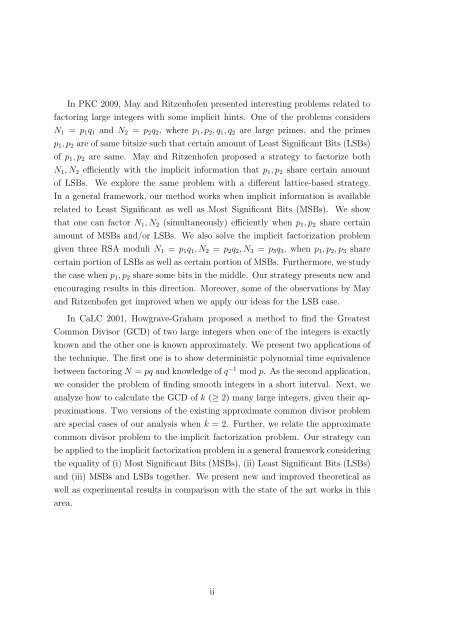Cryptanalysis of RSA Factorization - Library(ISI Kolkata) - Indian ...
Cryptanalysis of RSA Factorization - Library(ISI Kolkata) - Indian ...
Cryptanalysis of RSA Factorization - Library(ISI Kolkata) - Indian ...
You also want an ePaper? Increase the reach of your titles
YUMPU automatically turns print PDFs into web optimized ePapers that Google loves.
In PKC 2009, May and Ritzenh<strong>of</strong>en presented interesting problems related to<br />
factoring large integers with some implicit hints. One <strong>of</strong> the problems considers<br />
N 1 = p 1 q 1 and N 2 = p 2 q 2 , where p 1 ,p 2 ,q 1 ,q 2 are large primes, and the primes<br />
p 1 ,p 2 are <strong>of</strong> same bitsize such that certain amount <strong>of</strong> Least Significant Bits (LSBs)<br />
<strong>of</strong> p 1 ,p 2 are same. May and Ritzenh<strong>of</strong>en proposed a strategy to factorize both<br />
N 1 ,N 2 efficiently with the implicit information that p 1 ,p 2 share certain amount<br />
<strong>of</strong> LSBs. We explore the same problem with a different lattice-based strategy.<br />
In a general framework, our method works when implicit information is available<br />
related to Least Significant as well as Most Significant Bits (MSBs). We show<br />
that one can factor N 1 ,N 2 (simultaneously) efficiently when p 1 ,p 2 share certain<br />
amount <strong>of</strong> MSBs and/or LSBs. We also solve the implicit factorization problem<br />
given three <strong>RSA</strong> moduli N 1 = p 1 q 1 ,N 2 = p 2 q 2 ,N 3 = p 3 q 3 , when p 1 ,p 2 ,p 3 share<br />
certain portion <strong>of</strong> LSBs as well as certain portion <strong>of</strong> MSBs. Furthermore, we study<br />
the case when p 1 ,p 2 share some bits in the middle. Our strategy presents new and<br />
encouraging results in this direction. Moreover, some <strong>of</strong> the observations by May<br />
and Ritzenh<strong>of</strong>en get improved when we apply our ideas for the LSB case.<br />
In CaLC 2001, Howgrave-Graham proposed a method to find the Greatest<br />
Common Divisor (GCD) <strong>of</strong> two large integers when one <strong>of</strong> the integers is exactly<br />
known and the other one is known approximately. We present two applications <strong>of</strong><br />
the technique. The first one is to show deterministic polynomial time equivalence<br />
between factoring N = pq and knowledge <strong>of</strong> q −1 mod p. As the second application,<br />
we consider the problem <strong>of</strong> finding smooth integers in a short interval. Next, we<br />
analyze how to calculate the GCD <strong>of</strong> k (≥ 2) many large integers, given their approximations.<br />
Two versions <strong>of</strong> the existing approximate common divisor problem<br />
are special cases <strong>of</strong> our analysis when k = 2. Further, we relate the approximate<br />
common divisor problem to the implicit factorization problem. Our strategy can<br />
be applied to the implicit factorization problem in a general framework considering<br />
the equality <strong>of</strong> (i) Most Significant Bits (MSBs), (ii) Least Significant Bits (LSBs)<br />
and (iii) MSBs and LSBs together. We present new and improved theoretical as<br />
well as experimental results in comparison with the state <strong>of</strong> the art works in this<br />
area.<br />
ii
















